The deadlift is undoubtedly one of the most popular exercises in weight training. While in powerlifting it is one of the three exercises that matter on competition day, numerous bodybuilders also make use of lifting a barbell from the floor. Due to the fact that it involves the entire body, this exercise is considered a fundamental measure to increase strength and muscle development. Even though the correct execution of the deadlift often requires a lot of training before you should handle heavy weights, it can actually reduce the general risk of injury with proper technique. But which of the many variations is right for you?
The deadlift is one of the most important basic exercises in strength training and is also used in other sports to improve strength and athleticism as well as build muscle mass.
Numerous muscle groups are involved:
- Erector Spinae: Also referred to as the back extensor, pulls along the spine from the sacrum to the occipital crest.
- Leg Flexor: The muscles on the back of the thigh.
- Quardriceps: The extensor of the leg on the front of the thigh.
- Gluteus maximus and medius: The hip extensor muscles that form the buttocks.
- Abdominal muscles: The trunk muscles on the front of the body including the straight abdominal muscles that form the “six pack”.
- Adductors: The muscles on the inside of the thighs.
- Gastrocnemius and soleus: The muscles that form the calves.
- Latissimus dorsi: The large muscle layer on either side of the back.
- Trapezius: The hooded muscle that covers the neck and upper back.
- Rhomboids: The muscles between the shoulder blades.
- Deltoid: Involves especially the posterior portion of the shoulder.
- … and many more
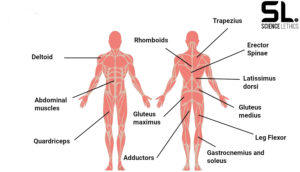
Almost the entire body is trained during the deadlift.
Different types of deadlift
Not all deadlifts are the same. There are different ways of performing them, which stress the body in different ways. For this reason, you should know which variation is best for you personally.
There are four basic ways to perform the exercise:
- Conventional deadlift
- Sumo deadlift
- Deadlift with the trap bar
- Deadlift with extended legs = Romanian deadlift
Knowing the difference between the variations helps to understand how they affect the body and which type is right for which goal.
- Conventional deadlift
The conventional deadlift is probably the most commonly used version of the exercise and most gym-goers should be familiar with it. Powerlifters, bodybuilders, strongmen, they all use the conventional lift equally. Cross Fitters, weightlifters and athletes from other sports also make use of this variation to develop balanced body strength and fitness.
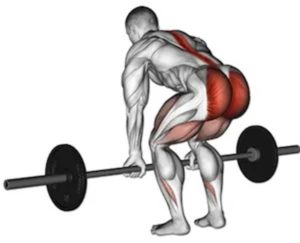
How to perform it
- Place your feet shoulder to hip width apart. The midfoot should be under the barbell and the shins close to the bar.
- Bend down and grasp the barbell outside your legs in an overhand grip or with one hand in an overhand grip and one in an underhand grip.
- Extend your arms, lift your chest, pull your shoulder blades back and position your hips about midway between the level of your shoulders and knees.
- Keeping your arms and back extended, press your feet into the floor, tighten your abdominals, and stand up. Do not lean back in the up position.
- Lower the weight with your back stretched and shoulders pulled back, and repeat the movement after a brief stop on the floor.
According to scientific studies, the conventional deadlift is particularly hard on the back extensor and the lumbar spine [1]. The reason for this is that at the beginning of the movement, the upper body is held at a steep angle to the thighs, which increases the distance between the dumbbell and the hips. Putting more stress on the lumbar spine is not necessarily a bad thing, especially if there is no pre-existing condition and the goal is to build up a lot of strength and muscle in the back extensor, gluteus and leg flexors. The conventional deadlift offers the largest range of motion of all variations, which makes this variation predestined for muscle building.
However, this variation may not be the best choice especially for tall athletes with back problems or when lower back pain limits the training weight.
- Sumo Deadlift
Sumo deadlift is performed with a much wider stance than conventional deadlift. This variation owes its name to sumo wrestlers, who take a similarly wide stance in combat. Because of the shorter distance the barbell must travel, many powerlifters choose this alternative to be able to move more weight. However, it is not the best choice for general muscle building.
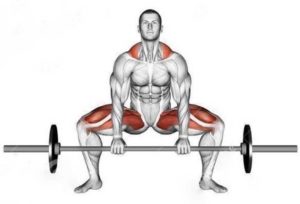
Sumo deadlift involves a particularly wide stance.
How to do it
- Place your feet about one and a half times as wide as your shoulders. Turn your toes outward so they point in the same direction as your knees. Your feet should be under the dumbbell.
- Bend down and grasp the dumbbell inside your legs in an overhand grip or with one hand in an overhand grip and one in an underhand grip.
- Extend your arms, lift your chest, pull your shoulder blades back and push your knees apart.
- Keeping your arms and back extended, press your feet into the floor, tighten your abdominals and stand up. Do not lean back in the up position.
- Lower the weight with your back extended and shoulders pulled back, and repeat the movement after a brief stop on the floor.
The sumo deadlift starts with a much more upright upper body. This means that it puts less stress on the lower back. Research confirms that it does, however, involve the quadriceps more [2]. Furthermore, greater mobility in the hip joint is necessary to perform this variation properly and without injury. Due to the lower load on the lumbar spine, sumo deadlift is also a better choice for athletes with pain in this area. While you are able to move more weight, this does not mean that you will also build more muscle mass.
- Trap Bar Deadlift
The trap bar deadlift, often referred to as the hex bar, is a sort of hybrid between the conventional deadlift and the squat. However, instead of on your shoulders, you hold the weight in your hands.
How to perform it
- Position yourself between the handles of the trap bar. Bend down and grasp the barbell so that your palms are facing inward.
- Extend your arms, lift your chest, pull your shoulder blades back and lower your hips.
- Keeping your arms and back extended, press your feet into the floor, tighten your abdominals and stand up. Do not lean back in the up position.
- Lower the weight with your back extended and shoulders pulled back, and repeat the movement after a brief stop on the floor.
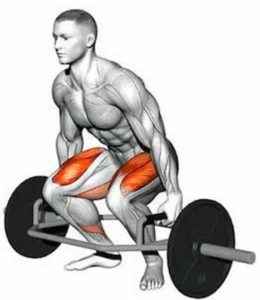
This variation allows you to keep your upper body more upright than in conventional deadlifts, but not as upright as in sumo deadlifts. Instead of being in front of the body, the load is next to it, thus lowering the load on the lumbar spine. Especially tall athletes and people with back problems benefit from this alternative. In addition, lifting with this bar activates the quadriceps more than the conventional method [3].
- Deadlift with legs extended –Romanian deadlifts
This is the only variation of the deadlift in which the weight is generally not set down between repetitions. Here, the knees remain extended as far as possible, except for a slight bend, but not completely pushed through.
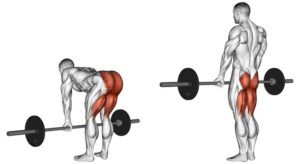
When deadlifting with extended legs, especially the leg flexor is activated.
How to perform it
- Place your feet shoulder to hip width apart. The midfoot should be under the dumbbell.
- Bend down and grasp the dumbbell outside your legs in an overhand grip or with one hand in an overhand grip and one in an underhand grip.
- Extend your arms, lift your chest, pull your shoulder blades back. Bend the knees slightly, but remain in a fixed position, keeping the position of the hips just below the shoulder.
- Keeping your arms and back extended, press your heels into the floor, tighten your abdomen and extend your hips. Do not lean back in the top position.
- Lower the weight with your back and knees extended and shoulders pulled back to the point where leg curl mobility does not allow for further lowering and repeat the movement.
Due to the strong inclination of the upper body, especially the leg flexor is activated. It is also involved in the extension of the hip, whereas the quadriceps are only slightly loaded. Since the weight is not set down, the muscles must remain constantly under tension, which means that less weight can be used. For this reason, the back extensor and lumbar spine also do not experience maximum load. The limiting factor is usually the leg flexor, which is why this deadlift variation is also considered more of a leg flexor exercise compared to the other variations.
Summary and conclusion
When choosing the right cross lift variation, you should consider both your goal and your injury status. If you train regularly with barbells, are free of lower back pain and want to train your back, gluteus, quadriceps and leg curls holistically, the conventional deadlift is the variation of your choice. If, on the other hand, you are looking for maximum loads, you can see if you can use more weight in the sumo variation. To prioritize the quadriceps, the trap bar deadlift could be an alternative to the squat, whereas the leg curl is activated especially by the straight leg deadlift. In the end, you don’t have to choose one variant, but you can integrate several alternatives into your training plan, depending on your goals.
You need proper guidance for your training comeback?
Do you already know our specially designed COMEBACK FITYEAR 2021 Training Programs? 4 dedicated program guides for beginner, as well as intermediate to advanced trainees, who want to become physical active again – at home or at the gym- after a layoff period. We wrote the COMEBACK FITYEAR 2021 Programs, so you can get back in shape – after a break, especially during those pandemic lockdown times. In the comfort of your own home, your own home gym or a commercial fitness club – we got you covered: from solely bodyweight based exercises to simple workout equipment like dumbbells and resistance bands up to a proper gym setup: this is exactly what you need to get a great and effective workout again, while still being able to progress and build muscle!
We are looking forward to your visit on our website. Click here and learn more now.
READY TO TRAIN LIKE A PRO?
LET’S GET YOUR GAINS BACK. TOGETHER.
____________________________________________________________
Primary source:
fitnessvolt.com/sumo-conventional-trapbar-deadlift
alphapnr.com/blog/which-deadlift-is-best-for-you/
References:
- Cholewicki, J., S. M. McGill, and R. W. Norman. “Lumbar spine loads during the lifting of extremely heavy weights.” Medicine and science in sports and exercise 23.10 (1991): 1179-1186.
- Escamilla, Rafael F., et al. “An electromyographic analysis of sumo and conventional style deadlifts.” Medicine and science in sports and exercise 34.4 (2002): 682-688.
- Andersen, Vidar, et al. “Electromyographic comparison of barbell deadlift, hex bar deadlift, and hip thrust exercises: A cross-over study.” The Journal of Strength & Conditioning Research 32.3 (2018): 587-593.
